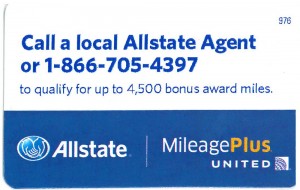Last week I received a mailer about the partnership between United Airlines and Allstate Insurance. The little envelope promised up to 4,500 United Mileage Plus award miles, trying to encourage me to switch insurance providers.
The offer goes on to say we can earn 2,500 bonus miles if we switch auto insurance providers. Second, earn an additional 2,000 miles by switching your home insurance. Sounds fair enough, but is it worth it? This was not one of those offers to get free miles just for getting a quote. We actually have to make the switch of insurance providers to earn the miles.
I wondered if maybe I was targeted for this offer, but looking at the United website, they do list the Allstate offer as an option for everyone; however, the offer is only limited to those residing in Arizona, Colorado, Idaho, Illinois, Kentucky, Maine, Missouri, New Hampshire, New Jersey, Nevada, New York, Ohio, Oklahoma, Utah, Washington, Wyoming and Washington D.C.
I found a couple of things interesting about this promotion.
1) There is no way to request a quote online, as you must call your local agent or 1-866-705-4397. Make sure you tell the agent you are applying under the United Airlines promotion, and include your account number.
2) While the online details state nothing about when the promotion is scheduled to end, the mailer we received did say the partnership will end April 14, 2013.
So if you are in the market for a new insurance provider, you may want to consider how Allstate compares to others.
Since I am not an insurance expert, I asked my lifelong agent for some commentary on how Allstate’s rates might generally compare to others. What I received back was a terrific commentary on the insurance industry that I feel really helps make a case for switching insurance providers.
As a customer, you may have noticed certain things are common and have always been throughout the insurance industry. For example, larger companies that spend huge amounts of money on brand building (such as Allstate) do a good deal of advertising, running promotions, and offering “innovative” coverages. Coverages such as vanishing deductibles, return bonus checks for safe driving, or United Airline miles did not exist 10 years ago. That is because the insurance industry is just as susceptible to trendy spending as any other industry and these companies spend billions figuring out the state of their customer base, the economy, and what appeals to them.
What does that amount to? Well, in a country where commercialism plays such a major role in spending, it is easy to make it look like you are getting more for your money when you throw out things that look like returns, or offer coverages that really do not mean much but sound fancy. You have to then ask, where does the money for all the very costly advertising, the guest spokesmen for the commercials, the airtime, the “bonus” coverages, the airline miles, come from? The answer without question is the consumer and always has been.
Brand building is a very expensive business, and traditionally the companies that are very vested in building their brand by commercialism will have gimmicky ways of attracting your attention away from the price of the premium for which you are actually paying for their product. It is a game of distraction and illusion. Magic always appears to be magic unless you know the trick. It is no coincidence then that traditionally those same companies have higher rates, or lower their rates for a time to move customers and then raise them again the next time they will be doing a major public relations spree.
Meanwhile, the customers who keep jumping ship for the better rates do not know that in the insurance industry everything is based on risk, and if you continually move companies for a better rate you look flighty. Flighty equals more risk, and while they may have saved a few hundred dollars over a few years, should they make this their habit they will actually increase their rates because they have now increased their risk factor, which increases their premium. The magic here is knowing that most consumers do not look at their savings over ten years, but over one year so they will never do the math to know they are losing in the deal. There is actually a discount (and by the way discounts are not actually ever discounts they are just another illusion that make you think you are paying less by highlighting where you are of lower risk, safe driver, customer loyalty, low mileage, etc.) for having multiple terms with the same company as this phenomenon works in reverse.
Once you learn the trick to the insurance magic, the benefits all disappear. The trick to the magic is, how much risk do you, your family, and your belongings pose to the company in terms of them having to pay claims (and what size claims) on you? That is it; that is what all the commercials, coverages, and gimmicks boils down to and what your premium is based on. There are intensely complicated logarithms that I do not pretend to understand that each company uses to assess your risk to them and they charge you accordingly based on which risk factors they value most.
Do rates vary greatly from company to company? Absolutely. Do stores have sales to get you in? Of course. It is the same premise, like the insurance company is having a “sale” and getting you in, and once you are there, most people are too comfortable to leave, especially if the rate increases magically happen on a small scale over a long period of time.
Now say you file a $50,000 claim and have only been with a company for a year. Will the insurance company raise your rate to try and re-coupe some of that loss? You betcha; you have not paid, nor will ever pay enough, into their system to cover the loss they just took on you. There is no magic there that is just simply your risk factor affecting your rates.
The other factor to consider before switching insurance providers is the customer satisfaction rate. The bigger a company is the more claims they have serviced, the more claims they have serviced, the more diluted their customer service reports become. They would have to have a lot of positive or negative customer service ratings at a time to impact their overall service rating. So people looking at a large company are not seeing the real picture unless the large companies makes some very major mistakes all at once. Nationwide experienced this a few years ago when they raised the homeowners rates by near 20-50% in one term, and went through major customer service revamping and changed their brand from the eagle to that empty box symbol. It did not work out so well for Nationwide and they are trying to recover now. The industry is very fluid.
One of the biggest and most difficult changes all the insurance companies, big and small, have had to face in recent years is the weather. The amount of claims based on weather is by far the biggest factor affecting rates in our area over the past 5 years, and it is a risk factor that is completely out of the industry’s control. So you will see a ton of industry shifting as the homeowner industry is now a negative profit proposition for the insurance companies, and they have to try and figure a way to suffer through this time. The insurance issuers will raise their homeowners rates without a doubt, but in different ways depending on what their sense of their industry is for their particular client base.
Some issuers will raise the auto rates to make it appear that the home rate did not increase as much if their auto rates were traditionally lower. Other companies will take small increases to home and auto yearly until they feel comfortable. Some will just take huge raises in the homeowners but keep the auto rates lower so people still feel like they are getting a deal if the auto rate is much higher somewhere else because of violations.
The major trick to the last model is that if you raise your rates up high at once, then people leave. When the next company raises their rates after the move, you can lower your rates back down, and boom you just got all those customers back plus probably more because now they are mad at the other company.
The major difference in those rate adjustment decisions is that homeowners rates are based partially on personal information and risk, but the other factors like weather and location play a major role in rates. On the contrary, auto policies are based on risk assessment that is based much more on the driver’s history with driving and paying. So the risk base between the two is vastly different and the companies have to do something to clot the bleeding wound that is now the homeowners insurance industry in this country.
Each company will address it differently but they will no doubt address it. They are losing money hand over fist and have been for several years so they have to stop the bleed or go broke. Whatever illusions they need to use to accomplish that will be up to the individual companies. Some companies have more money from previous rate increases to spend on creating these illusions than those that choose not to make major use of commercialism but rely more heavily on good service ratings.
So there you have it. Is it worth switching insurance companies for a couple of miles? If you are going to switch anyways, then you might as well sign up for this offer. However, it is not worth it to switch just for the sake of the miles.
Save Money, Travel More!
Source: InACents




Thanks for sharing. I’ve been preparing to shop my insurance coverages around. Might as well get some extra points if AllState is the best provider for my situation.